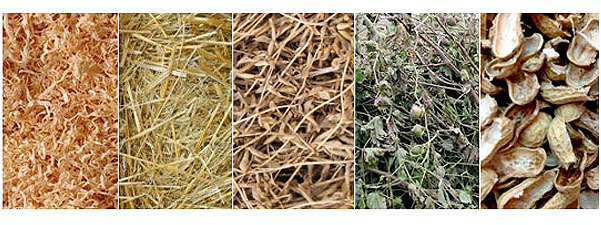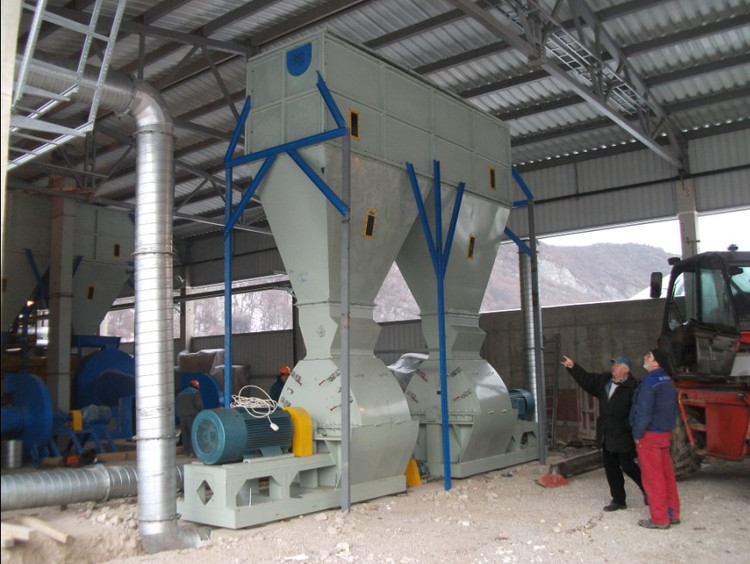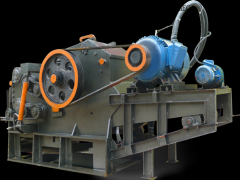Pellet Market and Production for Biomass Pellet Plants
Foundation of agricultural feedstock for agro-pellets production
Next to woody biomass as feedstock for the pellet production alternative resources are becoming more prominent. This development results on the one hand from an untapped potential of agricultural residues and on the other hand from a globally increasing use of wood residues and by-products for the provision of energy e.g. in the form of pellets and as raw material in the pulp and paper industry.

Agricultural residuals as straw, hay and husks as well as energy crops like miscanthus are the most popular raw materials for the agropellets production today. Further interesting resources are different types of grains and grass, olive kernels, rape cake and coffee husks, what presents a wide range of raw materials. The following description shall provide an overview on the most important agropellet markets in Europe as well as give a brief outlook on the future development and related challenges. Main studies that have been looked at concerning the agropellet production and use in Europe are the pellets@las project providing an overall picture of the European markets and the MixBioPelletss project with a focus on alternative raw materials for the pellet production in 7 European countries and regions respectively (both projects have been supported by the European IEE-programme). In some cases regional experts could provide estimates what supported the results. Countries with significant developments and activities in this area so far, even though they are small in comparison to the wood pellet market, are Denmark, Poland, the Czech Republic, the Ukraine, and the United Kingdom. Besides, various Eastern and Southern European countries as Slovakia, Hungary and Italy show increased activities in this field. However, in the majority of the European countries an agropellet market does not exist yet. In general it can be observed that countries with a distinct agricultural sector and little forested areas qualify for a development and expansion of an agropellet market. In the following section the most important markets are briefly described and general conclusions on the state of development are drawn.
READ: HOW TO START A BIOMASS PELLET PLANT
Market Overview
The beginning of the production of agropellets in the Czech Republic dates back to the early 2000s. Since then the market has experienced a steady growth. Today the production amounts to 110,000 t (2009). Agropellets are produced and consumed locally. So far little trading activities can be observed, thus in 2009 10,000 t have been imported. The main raw materials are straw, hay and other grain residues. The market is expected to grow further and the future plantation of energy crops is also conceivable on the Czech market. In Denmark the yearly production of straw pellets is about 100,000 t. This volume is produced by one large manufacturer and is dedicated to one power plant. The utilization of biomass especially straw and wooden residues in large power plants has been stimulated by the Biomass Agreement of 1993 and its adjustment in 2008. Besides, there are a few small agropellet producers without a significant throughput. Due to this setting, market structures like the introduction of further producers (medium- and large-scale) and consumers and the price formation for straw pellets could not establish properly yet. As in Denmark there is also one main straw pellet production plant (production volume 100,000 t) in the United Kingdom, which directly supplies a coal power plant where the straw pellets are co-fired. Moreover there are a few producers with comparably small production quantities of agropellets based on miscanthus and straw. In the UK co-firing of biomass is incentivised under the Renewables Obligation Certificates Scheme what supports the use of pellets for the electricity production. Furthermore, the limited availability of woody biomass in the UK also gave an impetus for the development of alternative resources. Next to Denmark and the UK also Poland uses agropellets for electricity production in co-firing plants. As in the UK the use of biomass for co-firing is promoted under the so-called Green Certificate Scheme. There the focus is especially on the predominant use of agricultural residues and products. The utilized pellets are made from especially sunflower husks and miscanthus. For the supply of the power plants considerably amounts of sunflower pellets are imported from the Ukraine. The local production of agropellets is estimated to 40,000 t

In 2009 the production volume of agropellets made from sunflower husks amounted to 190,000 t in the Ukraine. For 2010 a doubling of this number was estimated. So far only sunflower husks are used as a raw material for agropellets. However, a huge future potential is seen in straw. 90 % of the production volume is exported, mainly to Poland. The domestic market is not developed yet and pellets are hardly used on national level. Further interesting and significant agropellet markets with a still unexploited potential are Hungary, France and Germany; countries that are traditionally shaped by agriculture. In Hungary several activities on the usage of agropellets for energetic purposes could be noticed in the past 3 years. In 2009, 4,000 t of agropellets have been produced; a still small amount. 90 % of the production volume was consumed within the country. Also in France the annual production quantity is very little (8,500 t in 2009) and fully supplied to the domestic market and applied in small-scale heating systems. However, a larger amount of agropellets is produced for the utilization as animal feed. Thus, the expertise of agropellet production already exists within the country. The market structure in Germany is pretty similar to the one in France. The overall production volume of agropellets for energy provision is very little and some producers supply agropellets only as animal feed. Summarizing the activities concerning agropellets in Europe an overview on the different markets is given in Figure 5.8. There the state of development of the considered agropellet markets is divided into 3 categories: major activities (actual and significant production and/or consumption of agropellets for energetic purposes), few activities (production and/or consumption on demonstration level or rather small production and/or consumption volumes) and no activities so far. Besides, figures for the production volume (if known) and the most significant raw materials have been assigned to the countries with major and few activities.

READ: HOW TO BUY A BEST-QUALITY YET LOW-PRICE PELLET MILL
Trading Flows
The main trading activities are directly taking place between the producer and consumer within countries. As presented often the agropellet production is linked to a dedicated coal power plant where the pellets are co-fired. Hence production and consumption happen primarily locally. Of course, this is also due to the fact that in most of the countries with an agropellet usage governmental support programmes have incentivised and supported the emergence of such a market. Among countries a few trading streams can be noticed in particular between bordering regions. The trading figures for agropellets between countries are very small so far and in most of the cases not known. A significant stream can be noticed between the Ukraine and Poland. The export of sunflower husks from the Ukraine to Poland amounted to approximately 150,000 t in 2009. Further smaller streams are in the Mediterranean region and South East Europe.
Summary and Prospects
The research has revealed that statistics on market figures like production, consumption and trade of agropellets are hardly available. Many producers and consumers are small companies with corresponding small volumes making the collection of reliable figures difficult. At the moment agricultural residues especially straw and miscanthus are the most common raw materials for the agropellet production. Dedicated plantations of energy crops for the pellet production are still in their infancy. Agropellets are currently mainly used for co-firing in coal power plants. The use of agropellets in small-scale heating systems is not an option yet, what is mainly due to technical problems. However this lack of demand has resulted in unused installed production capacities. In particular in Italy and Spain facilities that can process various alternative feedstock for the pellet production have little output or even stand still.
The volume for Germany comprises of both agropellets and mixed biomass pellets and represents the output of a questionnaire at the beginning of 2011. No explicit figure for agropellets has been available. However, predominantly agropellets were produced. The agropellet production for the co-firing in power plants primarily takes place regionally. Besides, a few markets export the entire production quantity to this dedicated market. They do not have a national consumption. Markets that produce both for the national demand and for export are not in place since a sufficient international demand does not exist. Hence significant trading flows have not established so far. The mentioned facts on the status of the agropellet market in Europe underline the immaturity of the market. However, the use of available agricultural residues and by-products for energy purposes is a great opportunity to increase the supply to the market. Thus in the following paragraph the opportunities and threats to the agropellet market are discussed.

Prospects (opportunities and threats)
Considering an increasing competition for wood residues and by-products alternative resources can expand the supply for a sufficient pellet production. Especially the growing interest in co-incineration may provide an increasing demand for alternative raw materials as a substitute or complement to woody biomass. Hence the market of agricultural residues and energy crops in the form of a pellet can experience a growth. In particular the already existing knowledge and facilities for pelletizing herbaceous biomass for the animal feed industry supports a fast introduction of agropellets for energy generation.
However, there are threats towards a growth of the agropellet market. The utilization of agropellets in large heat and power plants turns out to be technically feasible and is practised. According to the European quality standard EN 14961 for solid biofuel the density of pellets is three to six times higher (550 to 600 kg/m3) in comparison to bales (100 to 220 kg/m3), what implies a higher energy density whereby noticeable reduced costs per transported ton can be realized. Nevertheless, the direct usage for example of straw bales is in many cases more efficient and outweighs the higher transportation costs and additional preparation steps before combustion in comparison to the processing costs for the production of pellets. Therefore, agricultural residues tend to experience some basic pre-treatment steps but not a complex pelletizing process. However with increasing transportation distances pellets become a more attractive alternative.
Considering the combustion in small-scale boilers the properties of the agricultural material pose in the currently available boilers a challenge concerning slagging, corrosion and emissions. In some countries regulations on the threshold values for the emissions of combustion installations constrain the utilization of agropellets, which are associated with higher emissions than for example the combustion of woody biomass. These aspects have hindered an appropriate use, and hence present a barrier to the diffusion of this application. There the development of the combustion technology is needed. Main activities can be observed from Austrian boiler manufacturers. They already offer boilers for the dedicated combustion of agricultural material.
====================================================================================
News
- Small Pellet Machine Manufacturer-Kingman
- Application of Wood Pellets and Use of Biomass Pellets
- From Fossil Fuel into Biomass Pellet Fuel
- Biomass Pellet Making Machines Market
- Applying of pellet stoves for home use
- Highland pellets to build $130 million facility in arkansas
- How to deal with the blocked hammer mill
- How to Make Wood Pellets with Sawdust
- The government policy promotes the development of biomass fuel
- Market analysis of biomass pellet fuel
- Strategic positioning of renewable energy
- Biomass energy has pass through the pre assessment
- The key point of deep processing of biomass pellet
- Harbin is promoting the development of biomass machinery
- The development of biomass formation technology I
- The development of biomass formation technology II
- Biomass energy industry is now going full tilt in 2015
- Rapid increasing demand of sawdust pellet on the market
- Pellet fuel market in EU
- Chinese Biomass Energy Conference held in Beijing
- Future market development of straw pellet mill
- Peanut Shell Pellet Mill Makes High Quality Pellets
- The utilization of straw is only 5%, biomass energy needs our attention!
- Corn straw pellet machine relieves the tight supply of fuel energy
- Reasons for loose or not forming of biomass pellet mill





